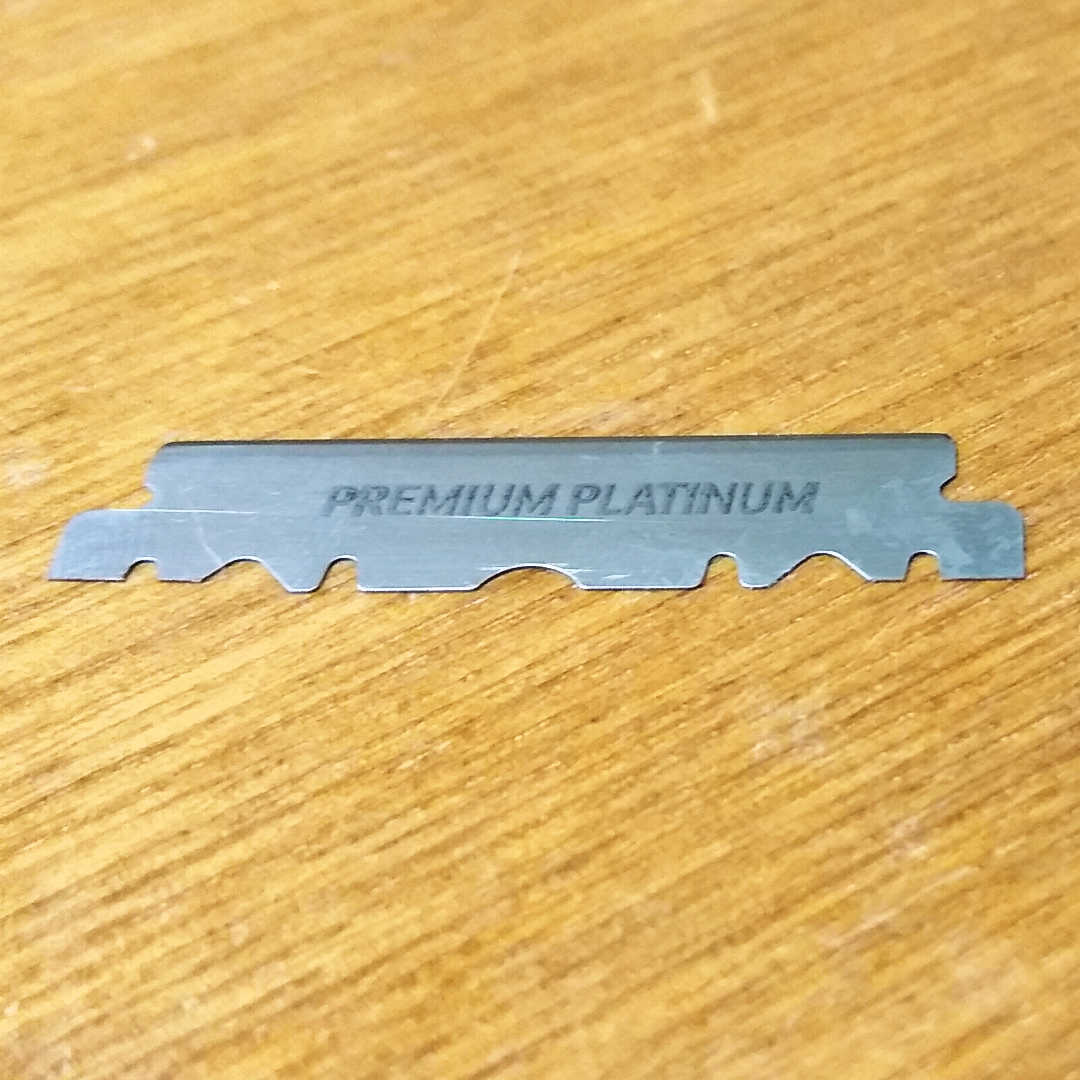
Single edge razors have gotten more notice over the past few years. Most use what I’ll call “single-purpose” blades (Injector, GEM, Feather FHS, etc.) but there are also single edge razors that use half of a double edge blade for smaller razor heads and the possibility of very economical shaving.
[Note: Amazon, Geni.us, Leaf, and Parker links are affiliate.]
Takeaways
A major usability aspect of the razors that use half of a double edge (“DE”) blade is the ability to use any brand of double edge razor blade. As shavers who routinely use DE razors know, DE blades may look alike but may perform quite differently. And everyone has their favorites: what works well for one person may not perform up to the expectations for another person.
So, unlike being forced into a “walled garden” of cartridge design, these users have a wide variety of blades in a standard form factor to choose from.
Contents
- Pre-Cut Half DE Blades Vs. Snapping A Full DE Blade In Half
- Leaf Shave
- Twig/Thorn
- Leaf Razor
- Parker SoloEdge
- Proof
- RazoRock ECO
- Maxwell June
- Focus Dynamic
- R48
- R50
- Summing Up And Recommendations
“Factory” (Pre-Cut) Half DE Blades Vs. Snapping A Full DE Blade In Half
Choosing between pre-cut half double-edge razor blades and snapping a full double-edge blade in half involves weighing several factors. Pre-cut blades offer convenience and precision since they come ready to use without any additional preparation, ensuring uniformity in size and shape as they are factory-cut. This can reduce the risk of injury and save time during shaving. However, the convenience of pre-cut blades typically comes at a slightly higher cost, and there might be fewer options available compared to full double-edge blades. Additionally, using pre-cut blades may generate more packaging waste due to individual wrapping.
On the other hand, snapping a full double-edge blade in half offers cost-effectiveness and flexibility. Full blades are generally cheaper than pre-cut half blades, and snapping them yourself allows you to customize the size to your preference. This method is also more environmentally friendly as it reduces packaging waste. However, manual snapping requires careful handling to ensure even halves and smooth edges, which could be time-consuming and potentially pose safety concerns if not done properly.
Complicating matters further, some half-DE razors require one type of cut! For example, Focus Dynamic’s razor heads require a manually-snapped blade, as the head design requires the little “curl” the blade makes at the snapping point to properly seat the blade to the head. These requirements will be noted below when necessary.
Specs?
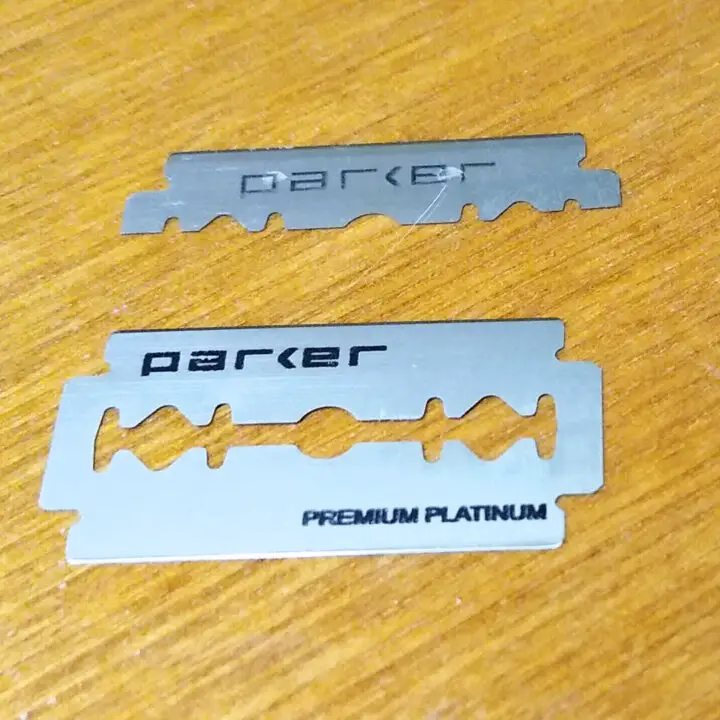
One final point. Blade specifications may be different between pre-cut blades and double edge blades of the same brand. For example, Parker double edge blades and Parker Half Blades are made to different specifications and may provide different shave characteristics.
Leaf Shave Twig/Thorn/Leaf Razor
Leaf Shave and Sharpologist have enjoyed a long working relationship together. Leaf offers several razors that use half a DE blade.
Twig/Thorn
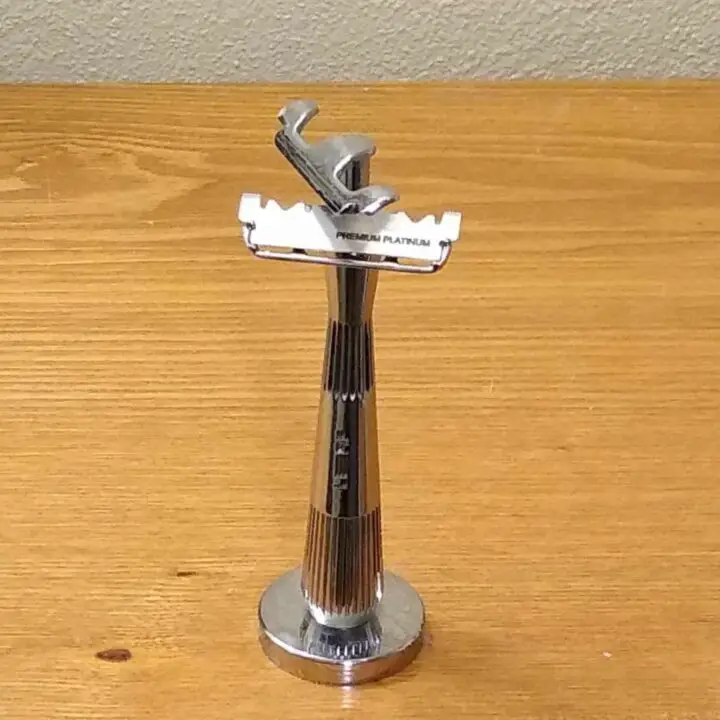
The Leaf “Twig” razor was launched in 2021 after a successful crowdfunding campaign.
- Weight: 2.5 oz (it’s about 68 grams without blade on my digital kitchen scale)
- Length: about 4 inches, head closed
- Materials: Zinc alloy
It looks good and “feels” substantial in the hand.
Loading a half DE blade can be a bit tricky since the blade is comparatively small. Loading a Twig may not be quite “stupid simple” but it’s very easy: get the blade close to the correct position and the magnetic head base holds the blade so you can just use the tip of your finger against a back corner of the blade (opposite the blade edge) to move it into position (popping into a post on each side of the head base).
The Twig loading/unloading mechanism is kind of similar (or at least familiar) to “twist to open” double edge razors: turn the bottom dial and the top of the razor head rises off the base and twists out of the way.
The Twig blade head is so small that it makes getting into tight areas (like under the nose or…ahem…”intimate areas”) a non issue.
Both “factory-made” half DE blades and DE blades snapped in half myself work fine for me in the Twig. This means you have a wide choice of blades that work best for you.
The shape of the razor makes it quite “bottom heavy” with a center-of-gravity near the bottom of the handle. I prefer “top heavy” razors with the center-of-gravity nearer the head but this is a personal preference. I still get comfortable shaves (from the hand-holding perspective) with the Twig.
I find the “sweet spot” of blade angle range comparatively wide with the Twig so I think it would classify this as a “forgiving” razor and I think the “aggressiveness” of the razor is somewhere between the typical cartridge razor and the average double edge razor. Of course the aggressiveness of the razor also depends on the specifications of the blade and here again you have a range of options, using different blade brands to make the Twig milder or more aggressive.
Some users of the Twig find the razor a little too mild so Leaf also offers the Thorn razor, which is more aggressive.
Click/tap here for a full review.
Leaf Razor
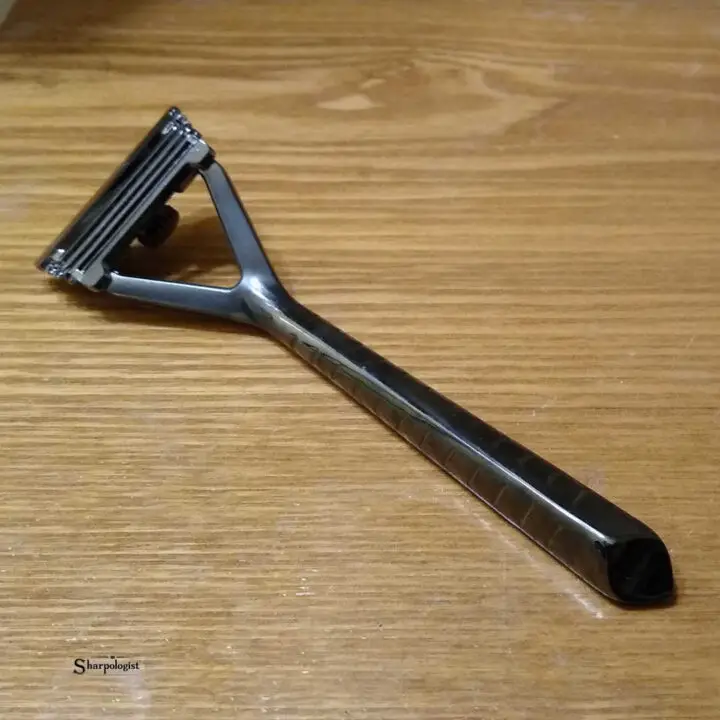
The original Leaf razor is an interesting razor. The shave experience would be familiar to both the shaver who has used a cartridge razor with a pivoting head and to the shaver who has used old school safety razor with a stationary head.
This razor can be loaded with one, two, or three half blades for a very flexible shave circumstance.
Like some cartridge razors, the Leaf’s pivoting head design gives the razor the ability to “hug” the surface of the skin as it curves. It also helps compensate for putting too much pressure on the razor (to a point).
Many shavers find the Leaf razor quite suitable for larger areas like the legs or the head, as well as shaving the face.
Click/tap here for a full review.
Parker SoloEdge
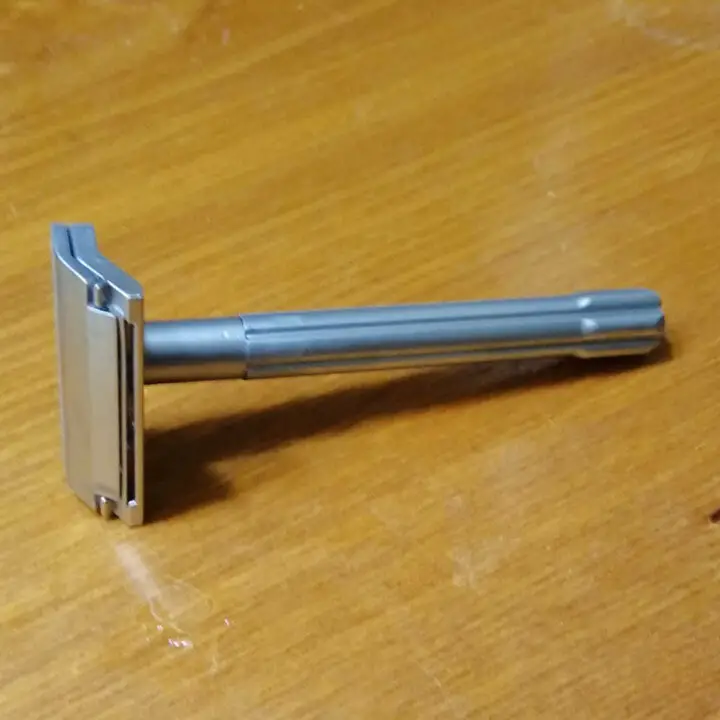
The Parker SoloEdge razor is the newest razor that uses a half DE blade.
- Weight: 94 g (3.3 oz.)
- Length: 9.8 cm (3.9 in.)
- Material: Solid Brass Handle with an electroplated satin chrome finish (head is molded from a metallic alloy and chrome plated)
Half-DE blades are small and can be a challenge to hold and load, especially if you have big, meaty hands. But, blade size aside, loading the SoloEdge is pretty straight forward. I tried it without looking at their helpful blade-loading video and I got it right the first time.
Like the Twig razor above, a small magnet in the head of the razor assists with loading.
Despite its weight and somewhat odd (for me) balance, I find using the SoloEdge quite comfortable to hold and use.
The design angle of the head makes for a natural and comfortable hand-hold for me. The razor head is thin enough so that getting into tight spots (like under the nose) is not a problem for me.
For me the blade angle “sweet spot”–the range of angles that provide the most efficient cut–is a bit narrower than other razors I have used. Nothing severe mind you, but something you may need to be more mindful of. There is a fair amount of blade-feel on this razor.
Rinse-through is good, though I think disassembling this razor periodically for a more thorough rinsing/cleaning is probably a good idea.
Click/tap here for a full review.
Proof
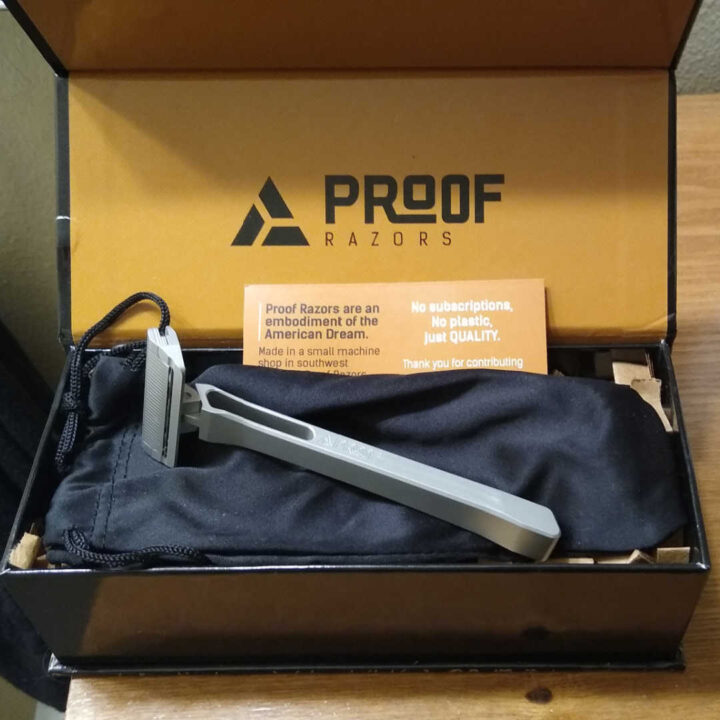
Proof razors recently launched an updated version of their original “High Proof” razor that uses half double edge blades and a front-facing head pivot.
There is a magnetic assist in the pivot base to facilitate blade loading (the original version had this feature too) and securing the razor’s top cap. According to the Proof website the magnets are stronger in this area.
The additional weight and length of the new Proof razor is appreciated and makes it feel more secure in my hand compared to the original razor. I still prefer a heavier and more knurled razor but the new Proof is certainly acceptable to me.
I think the new Proof razor is slightly less aggressive than the original razor: if the original is a “5” on a 1-10 scale I would say the new razor is about a “4.5.” I think there is a bit less blade-feel and general feedback as well.
Click/tap here for a full review.
RazoRock ECO
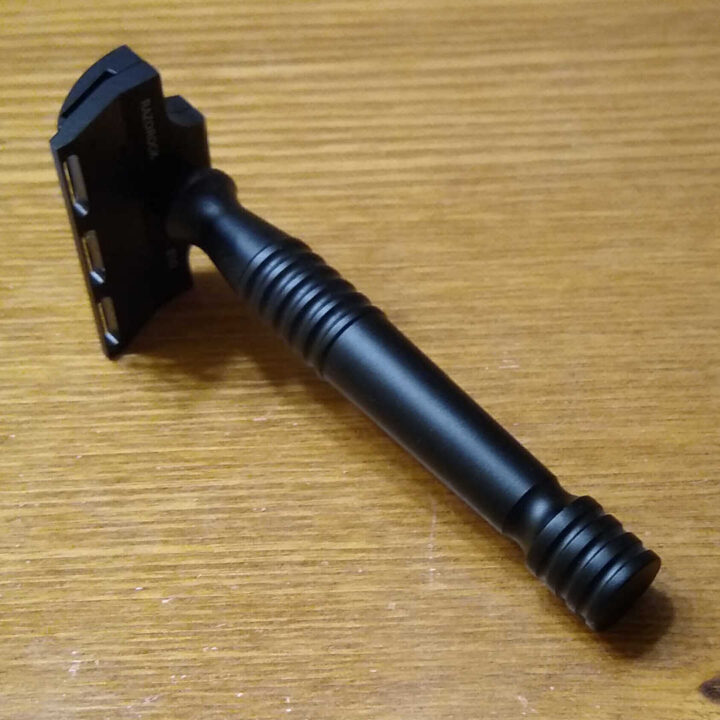
The RazoRock ECO razor has a fair amount of blade exposure. If I were to give it a number on a scale I’d say it’s a 5-6 on a 10 point scale for aggression: the high side of “average.” I prefer a razor at about 3-4. At about 1.3 oz. it’s a pretty lightweight razor.
The razor’s handle seems to grip well and I didn’t have any problems with it slipping from wet fingers.
A pet peeve I have with many single edge razors made by artisans is blade changing can be a real hassle. But that doesn’t happen to me when I use the RazorRock ECO: a half-DE blade just sort of slides into place and stays there when the razor is re-assembled.
Click/tap here for a full review.
Maxwell June
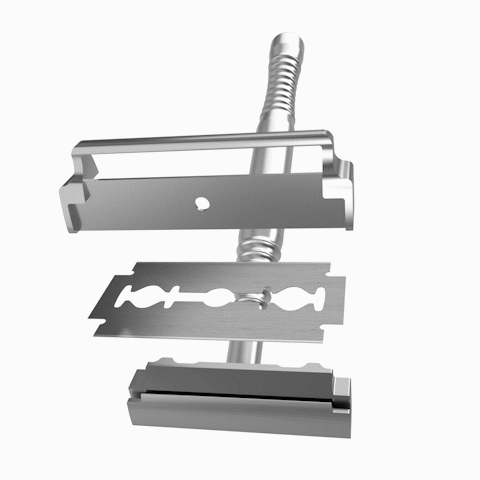
The Maxwell June razor is an all-American engineered- and produced-shaver designed to easily and safely deliver people into the world of sustainable and comfortable wet shaving, minus the potentially steep learning curve of your traditional double edge razor. This razor accepts the ubiquitous double edge razor blades, but gives you the equivalent comfort and convenience of the store-bought cartridge with a greatly reduced long-term ownership cost and minimized environmental impact. This razor comes with a “kit” that will automatically split a double edge razor blade and fit it into a twin-edge razor.
Click/tap here for a full review.
Focus Dynamic
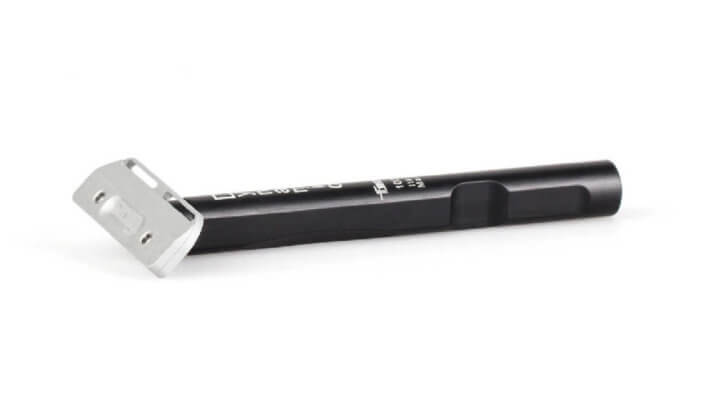
The Focus Dynamic series is an Italian-made razor.
R48
The 100mm handle is anodized aluminum (available in a variety of colors) with stainless steel parts in the head. It weighs a feathery 33 grams.
The Razor head’s spring-loaded pivot is designed to hold the blade at 25 degrees to the skin. Pivot travel is roughly 30 degrees.
The R48 requires snapped-in-half blade for support.
Click/tap here for a full review.
R50
The Focus Dynamic R50 razor is essentially the R48 without the pivoting head.
Summing Up
As you can see there are a number of razors that use half of a double edge razor blade, with more on the horizon (I will update this article as I try other razors!). What is the best? Depends on what you are looking for:
- If you prefer a pivoted-head razor, the Proof razor is an easy recommendation.
- If you prefer a non-pivoted razor, take a look at the the Parker SoloEdge or the Leaf Twig if you prefer a milder shave; the Leaf Thorn or the RazoRock ECO if you are looking for a more aggressive shave.
- The original Leaf razor is the way to go if you prefer shaving over a large area.
- The Maxwell June razor has the advantage of having a “hands-off” blade cutting and loading mechanism.

Nice article. Will have to look into a couple of those. I had a ECO but hated using it so much I gave it away. I prefer razors on the milder side but this gave me so much irritation no matter what angle, blade or handle I used. I did give Italian Barber some feedback and suggestions on improvements but so far as mine was the only complaint nothing has been done. Pity.
Great article, I love using my Leaf twig and the only issue I can see which may be a problem for some shavers, especially those used to a DE, is that the twig is very bottom heavy and doesn’t have the head weight of some DE razors, meaning that there is slightly less feel in my opinion.
Well thanks for this! I’m considering slimming down the collection and frankly I’m about to give up traditional DE in favor of SE. However, I have a whole bunch of DE blades and was trying to figure out what to do with them, then you mentioned Maxwell June. As I am trying to get rid of razors, you got me to get a new one! Hoping this is as good as it appears to be.
I own a Maxwell June razor and actually helped the manufacturer by providing feedback for the razor’s loading system. It’s a very good razor and I think you will enjoy it. Also, I own the Proof (High Proof) razor V1.0 and V2.0. You should not overlook this razor as it is very good. In fact, I used it this morning. In its current iteration, V2.1, Proof now includes a leather roll-up case that will hold the razor, blades, and perhaps a small brush.